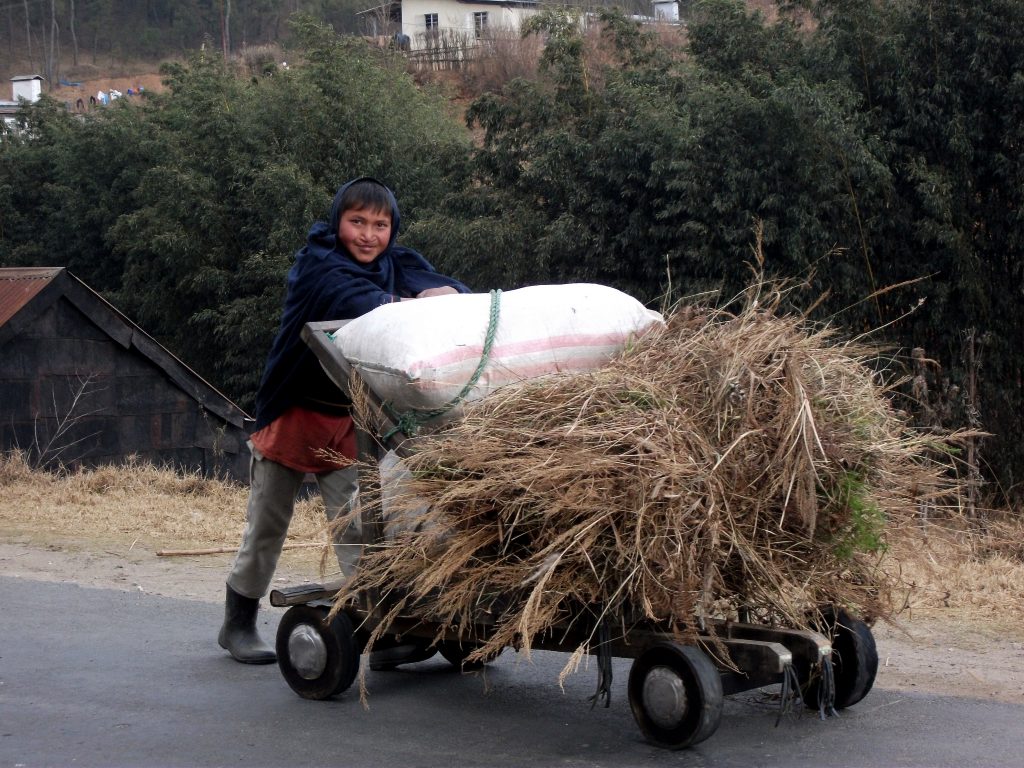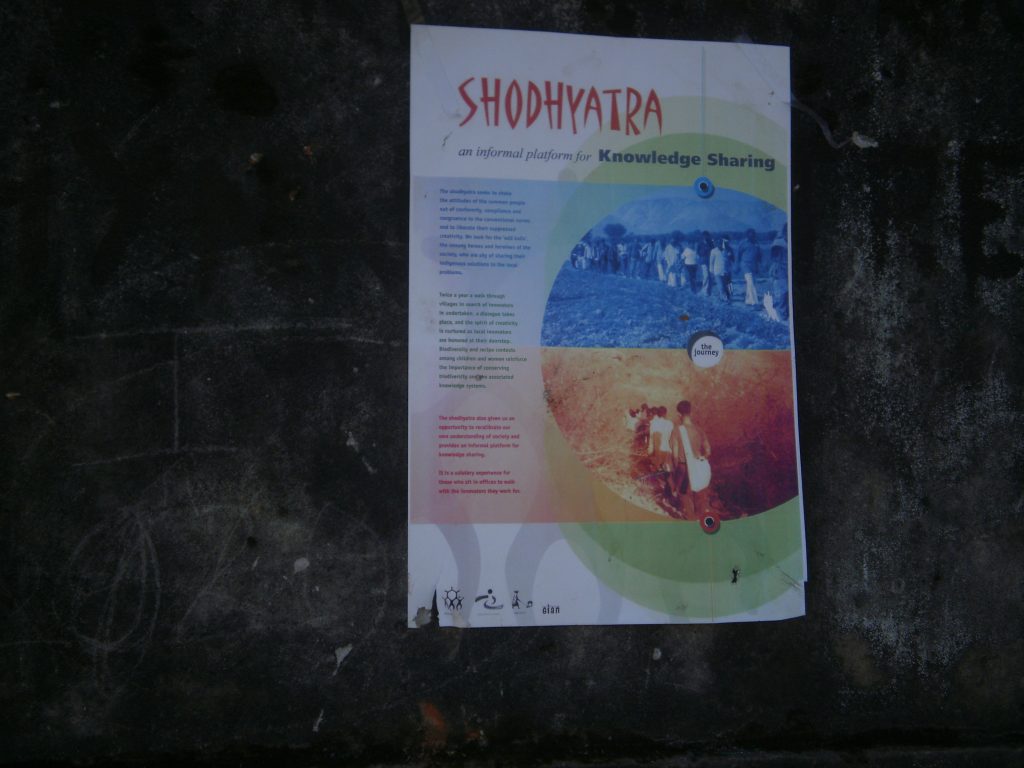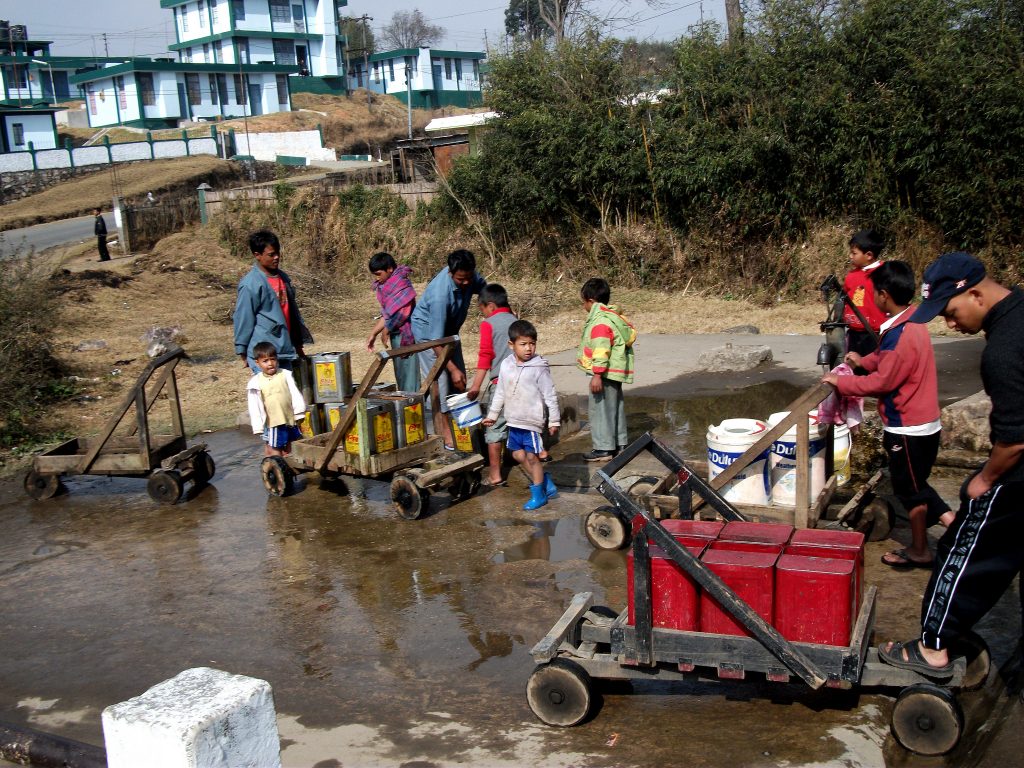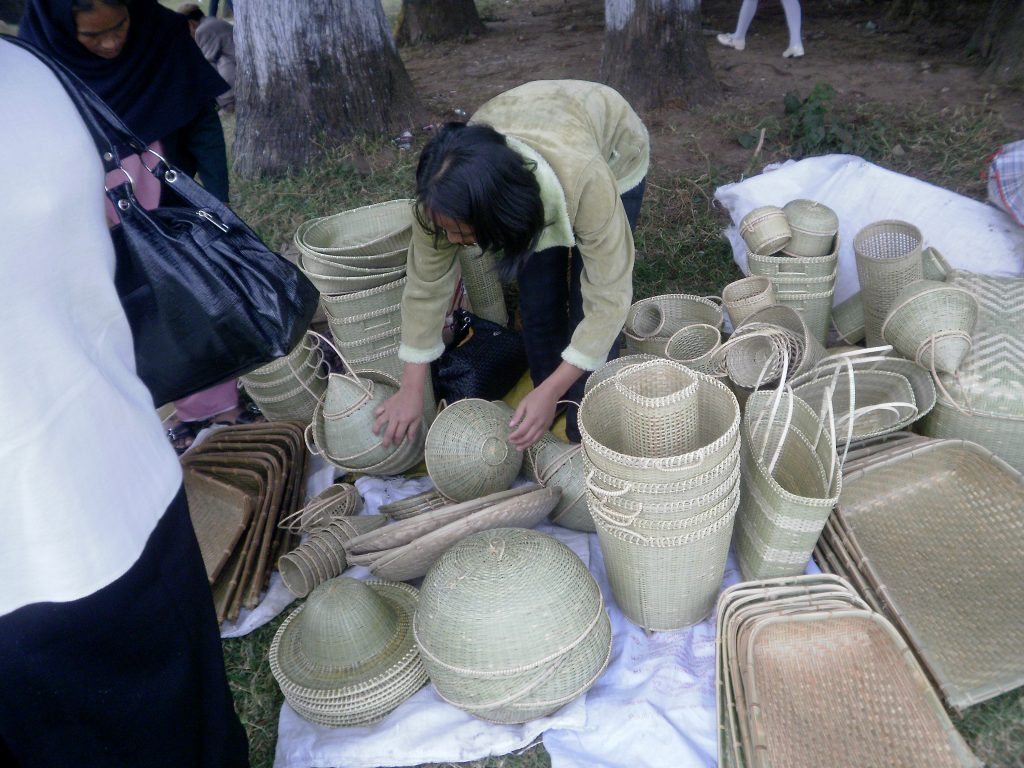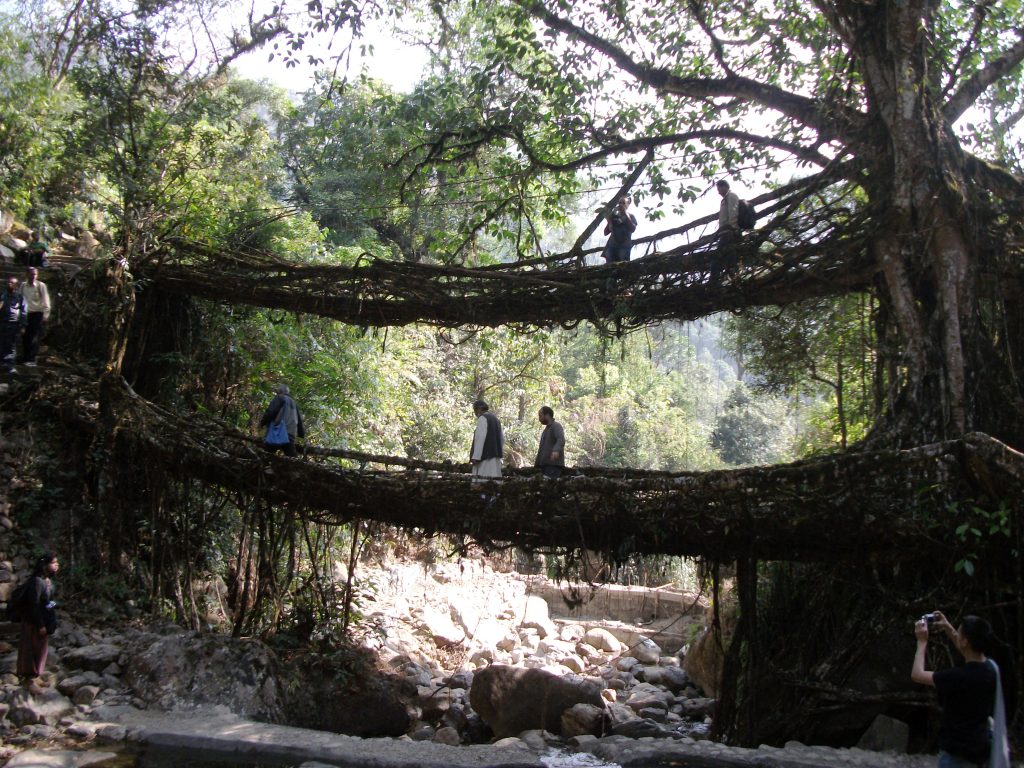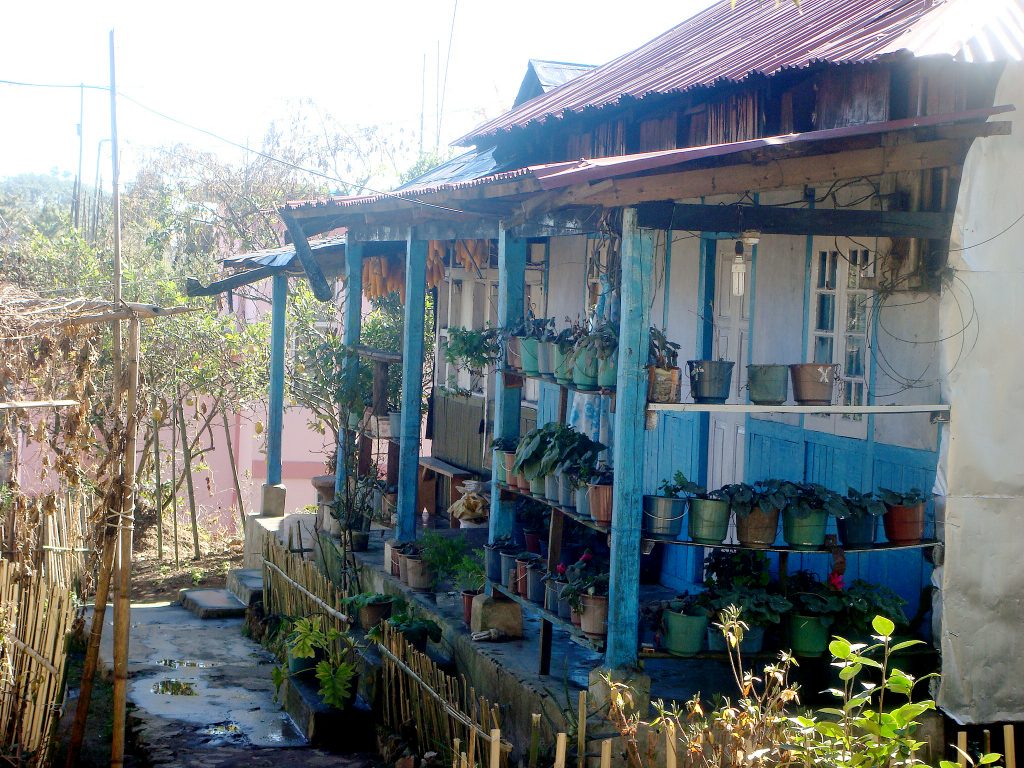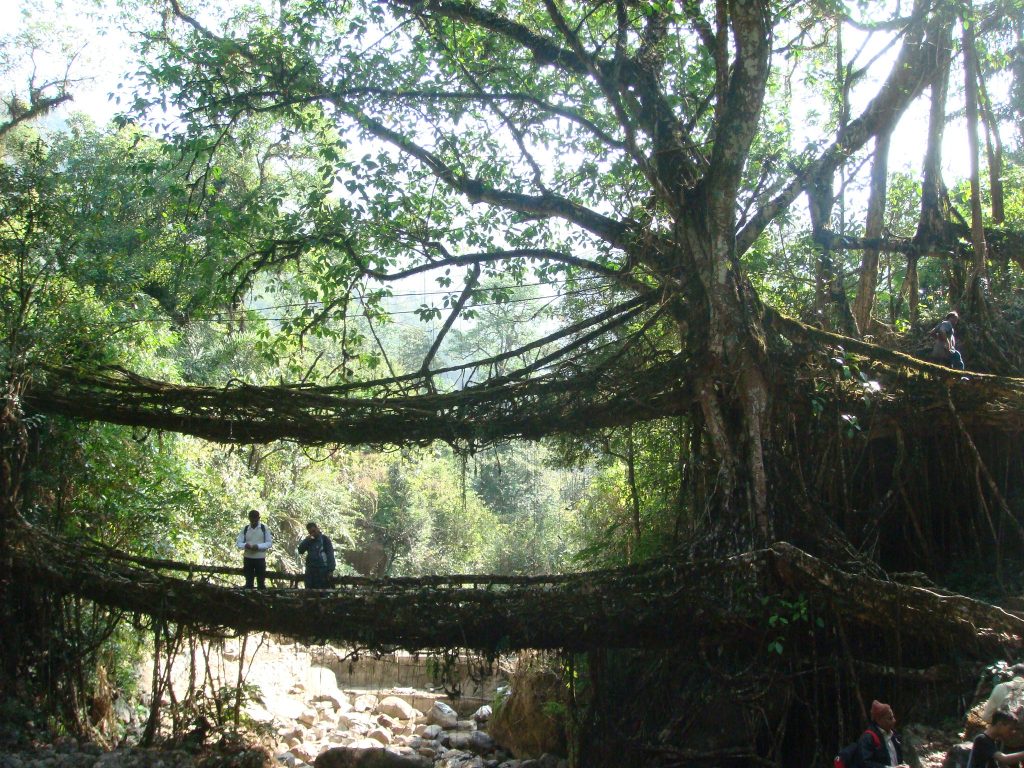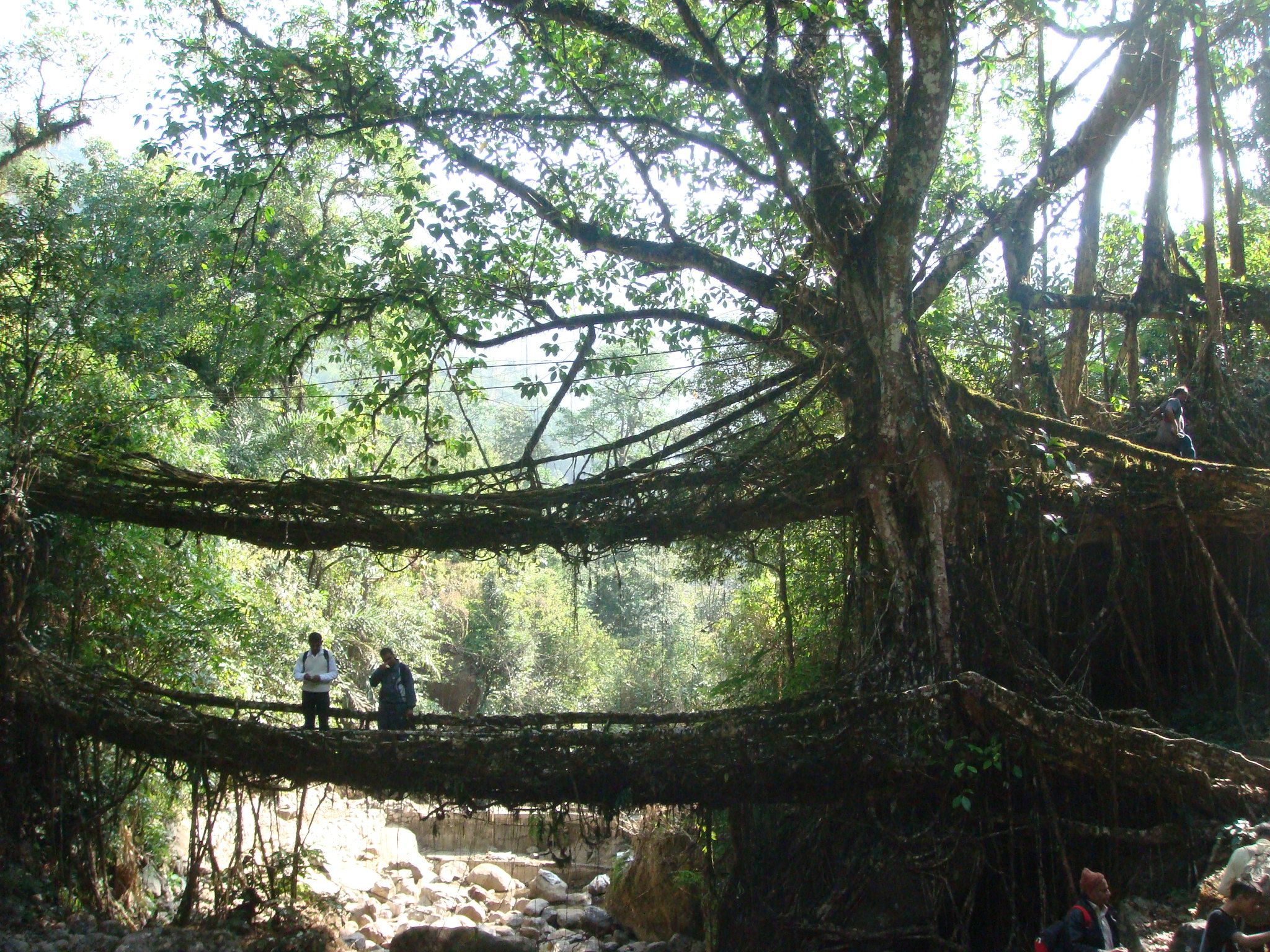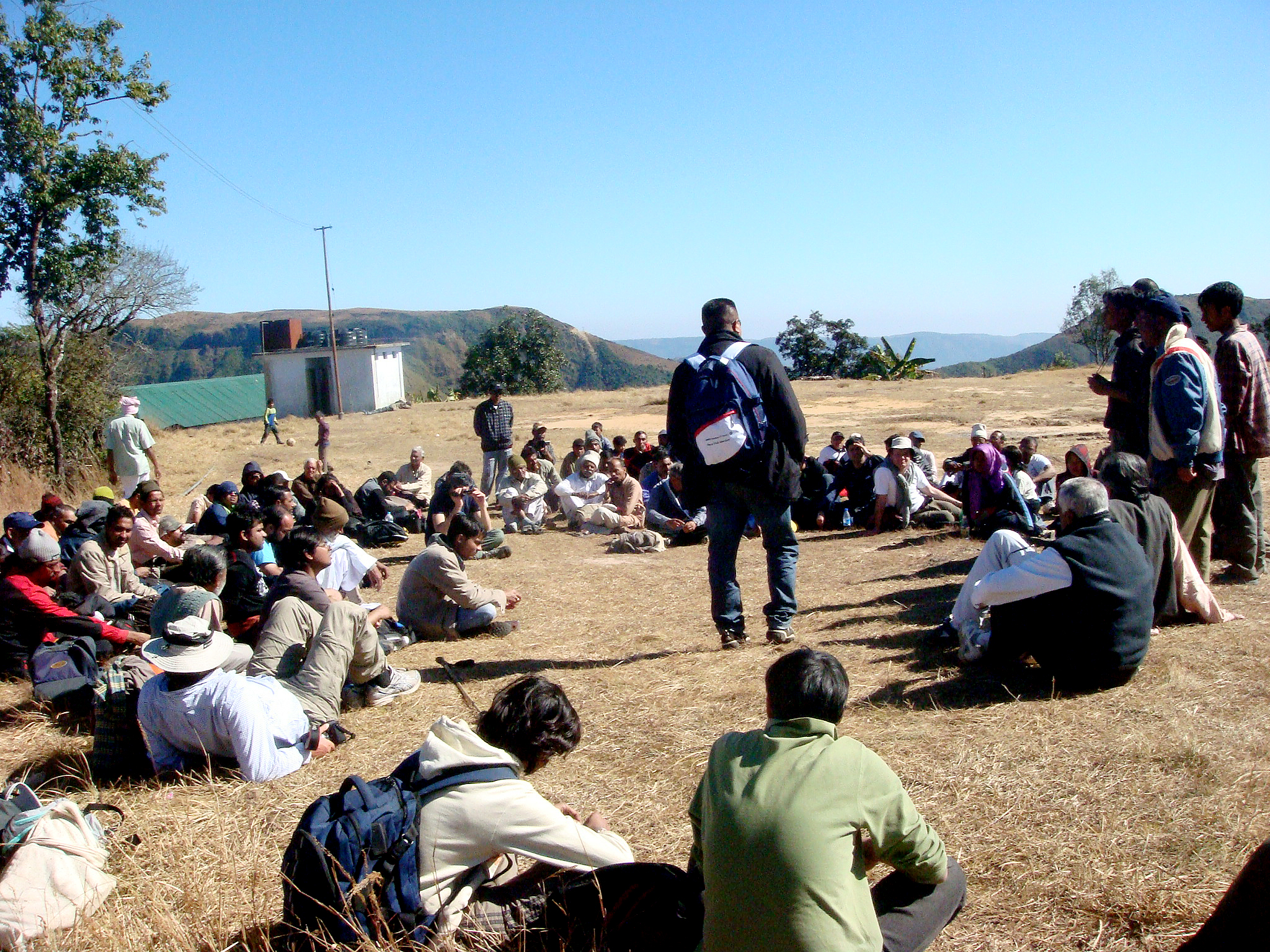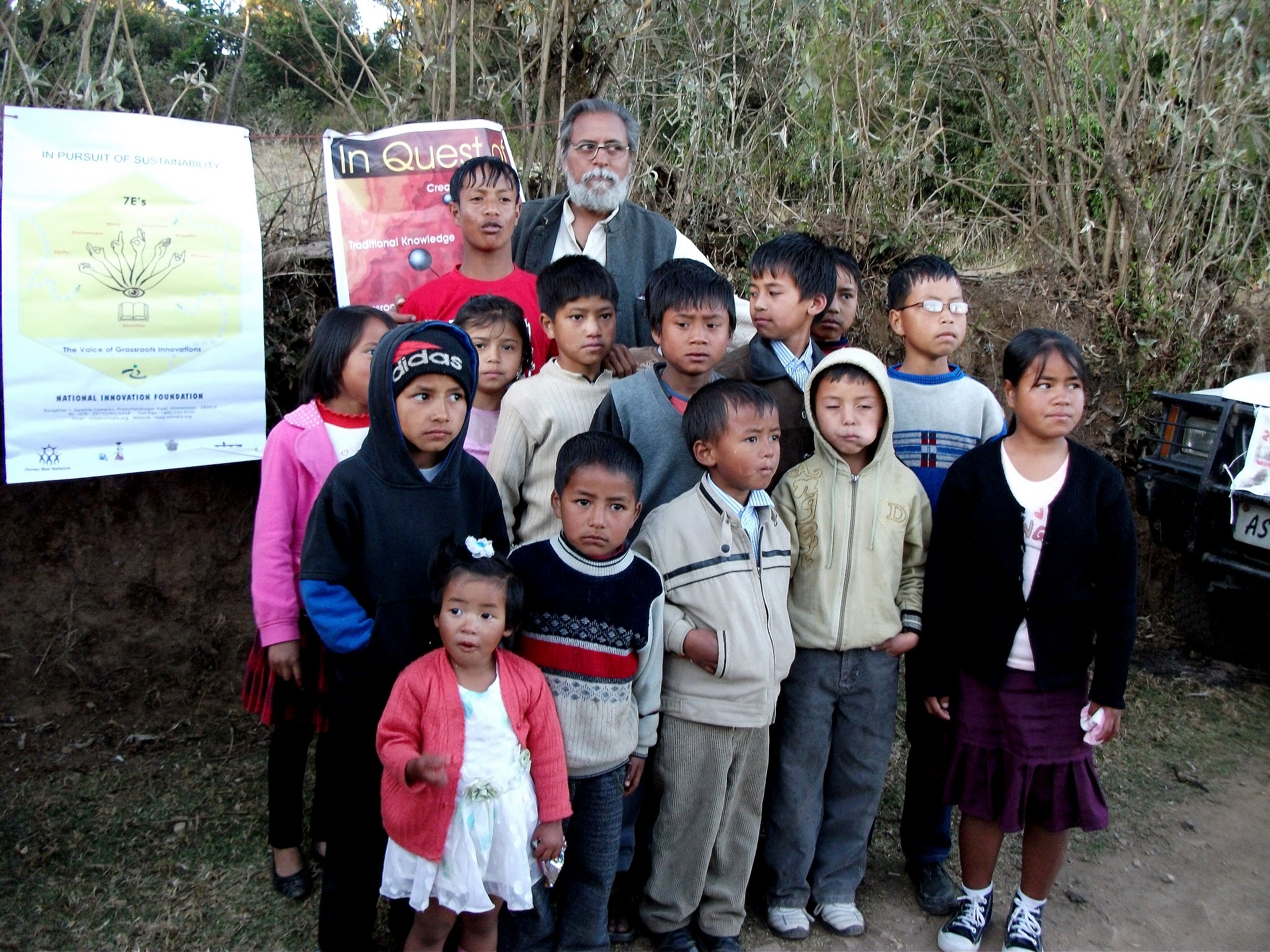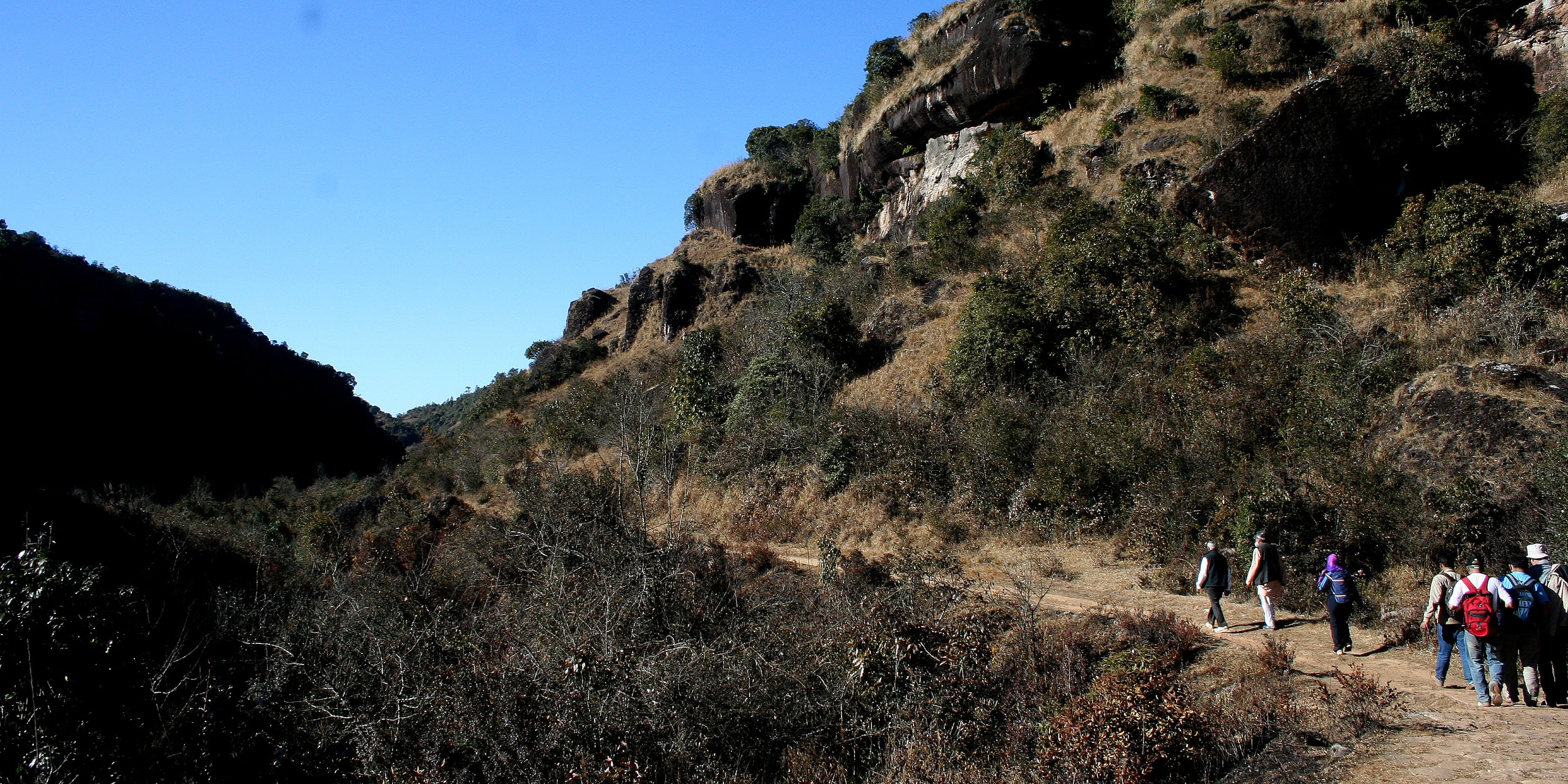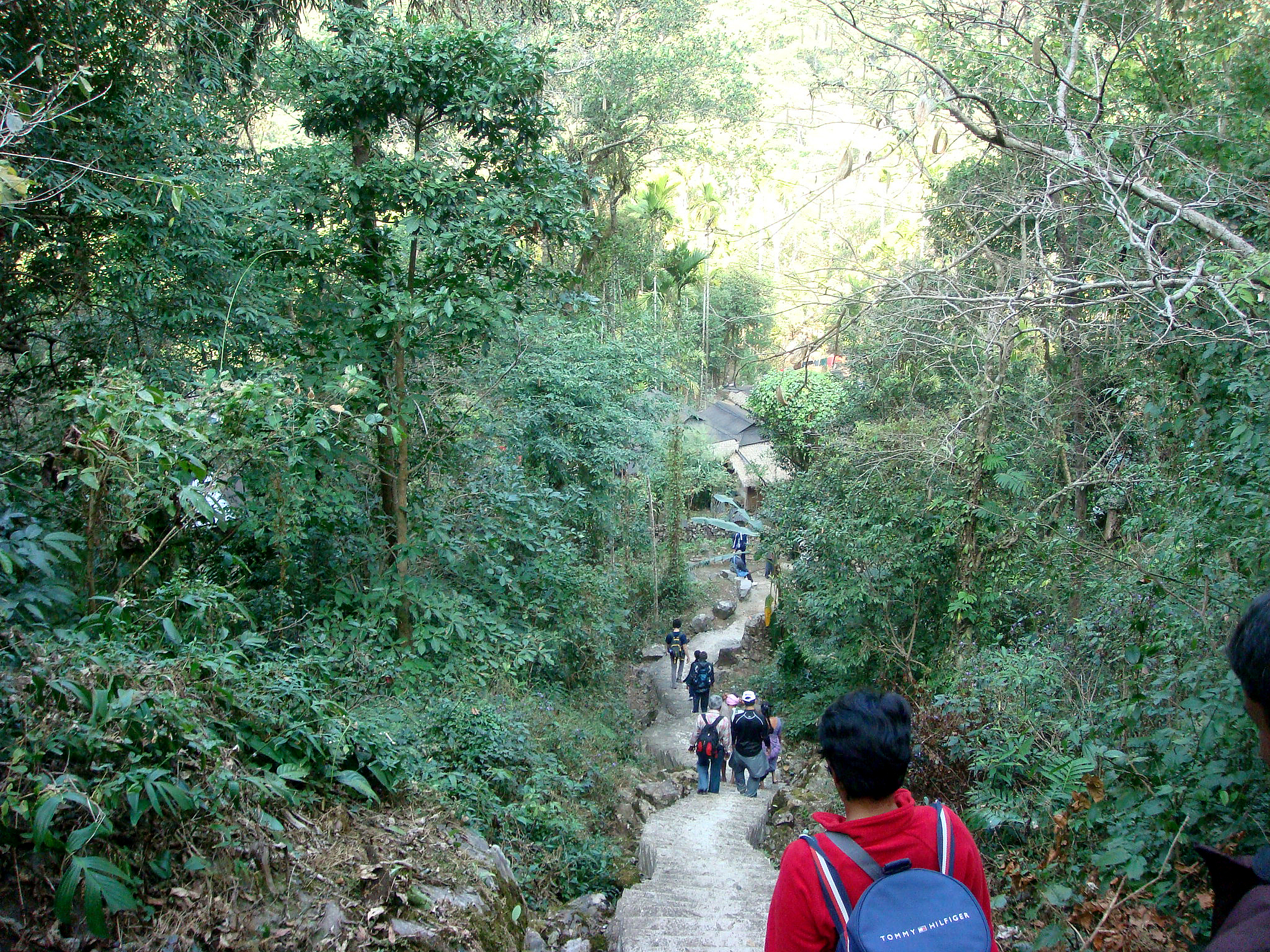Get Next Shodhyatra Update:
Phone:
079-27913293, 27912792
Email:
shodhyatra@sristi.org
26TH SHODHYATRA - EAST KHASI HILLS (MEGHALAYA)
January 3 – 9, 2011
VENTURING THE SOUTHERN SLOPES
Unless we interact and learn from the communities inhabiting perceived margins of our society, it is unlikely that the development process will become inclusive. More than a hundred people from different parts of the country and abroad decided to learn from the rich knowledge system in an otherwise disadvantaged region of Cherrapunji, Meghalaya state in January this year. Having walked through conflict prone areas of Narayanpur, Bastar last summer, yatris were keen to see if the region receiving highest rainfall in the world was a well fed, well managed and well looked after region or not. Images of beautiful mountains and water falls seldom reveal the pain that people may experience living there. May be time has come when one should also promote reality-tourism so that more and more people of the country realize what pain and stress people in other picturesque regions go through. We had felt likewise during our shodhyatra in Arku valley in Andhra Pradesh, another tourist destination. Of course, our mission always was to discover knowledge abundance in biodiversity rich but economically disadvantaged regions.
The Cherrapunji (Sohra sub division), in the East Khasi hill region in the North East part of our country was explored in the cold month of January this year. The shodh yatris walked enthusiastically for a week braving cold and long distances, to explore the Meghalaya (‘alaya’, home of Megh, the clouds). Bethany Society1, an NGO based in Shillong coordinated and helped SRISTI in arranging this Shodh Yatra.
Mr. Carmo, leader of Bethany Society at Laitumkhra explained various educational, vocational and other activities of the society. His own journey in the service of local communities was a quiet reflection on often forgotten fusion of diverse social currents of the country that ought to take place more and more. Mr. Pabok Diengdoh2, took great pains along with other Honey Bee Network volunteers in advance to prepare for the journey. His youthful energy was infectious for any yatri who was about to give up due to tough terrain. Yatris began interaction with local communities, herbalists, and others in Laitkynsew village, the starting point of the yatra.
Located approximately 50 km far from the state capital Shillong, this village has a wetland named as Riat Clif located in the north. It lies under the jurisdiction of syiemship of Nongkhlaw headed by a traditionally reverred leader, Sri. P. M. Syiem. Most of the Khasis still follow the traditional customs, imbued as they are with rich cultural and ecological ethics. They have a traditional village council locally known as dorbar. Master Modi Basaiamoit is the village head locally called as sardar.
The sardar is assisted by six executives who are called as matbar and a secretary of the council. With 250 households, main occupation here is cultivation of vegetables (potato, tomato, beet, spinach, cabbage, mustard seeds, carrot etc.), rearing cattle and poultry and wage labour. It starts raining from the month of March and continues till October.
Being near a tiger reserve, they don’t hunt tigers believing them to take care of indigenous deity (Ryngkew Basa), the supremo of the nature. If they kill the tiger, they fear that the deity will curse them with natural disasters. Besides they do not allow extraction of any resource from the nearby forest, treated as sacred groves. The village and its hamlets have four primaries, two upper primaries and a secondary school in the village.
Children and women participants of biodiversity and recipe competition respectively brought a variety of samples with them. Many children displayed samples of plants on charts along with their uses and others brought in hand. Ribakor Sohtum (class VI) won the first prize followed by Denilson Deingdoh (III), Indalumin Sohtum (II), Ibashongkun Sohtum (II) jointly second prize and Darikupar Malagiang (VII), Melarishisha Khongwir (VII) jointly won the third prize. As many as 71 plant specimens along with their local uses were documented in the process.
The herbal healers Ajnalin, Rishot Synrem, Jrishon Lyndgos, Jerland Matngian, Lilaiar Landroy, Sklida Diengdoh and Birot Sawian were facilitated in the meeting. Many of them had brought samples of medicines in addition to the plants used therein. Three ladies namely Mrs. Fullmerry Rajee, Mrs. Lumlang Warjri and Mrs. Laiar Lyndoh were felicitated for presenting their tasteful recipes. Later in the night, many yatris sat around the fire and talked with local community members about local culture, diversity and institutions.
We honoured a centenarian lady Kwir Warjiri (105) next morning and took her blessings for the movement. Her house received water through overhead bamboo channel. Many letterboxes outside the houses carried beautiful designs. As we walked further, a traditional water conservation structure was spotted. First stopover was in village Terna where large quantities of ‘Tej patta’ (bay leaves) sacks were seen lying by the roadside to be collected by the traders to sell in the market.
A stepped pathway of about 2000 steps preceded Terna letting yatris see the view of the plains of Bangladesh. On the way to living root bridge, we saw the only small check dam being built to conserve water. There were no other such dams to be seen all along the way. Some families
were having an outing on the river bank and cooking in the field. Before reaching ‘root bridges’, there was a ‘community tax collection point’ where a lady charged all yatris a small contribution used for maintenance of the bridge and habitat nearby! This idea is worth emulating at other such eco-fragile places as well. The ‘tax’ is entirely managed by the local community.
Some of the yatris tasted local variety of lemon fruits near the sacred tower in the village having board requesting donations. Crossing the world famous ‘double storied or double decker living root bridges’ was a unique experience for the yatris.
It is amazing to know that these bridges are not ‘built’ but are “grown”! These living root bridges are made from the roots of the Ficus elastica tree. Secondary roots grow out of this tree and these can extend themselves along the river banks uptill the middle of the river. Long time back, this unique feature was noticed by the war-Khasis (Meghalayan tribe). This was a wonderful way to be able to cross rivers. They simply grow their bridges whenever the need arises. The living root bridges take ten to fifteen years to become fully functional. These are more than a hundred feet long and are strong enough to support more than fifty people. It is believed that some of these are few hundred years old. The bridges become stronger as the time goes by. “Umshiang Double-Decker Root Bridge”, is a unique and one of its kind bridge in the world. This living root bridge is actually two bridges stacked over one another! We also learnt that the villagers worship these root bridges.
Honeybee rearing is common here. Villagers had made a unique bee keeping box which was simple and cost effective. Many houses were colourfully designed. Nearly each house has a hen-house and a garden with flowers and evenly cultivated vegetables and fruits.
On reaching Nongriat by noon, a simple yet efficient instrument named “Pomelo” for plucking oranges from the trees was seen. The yatris moved ahead after taking lunch here. Crossing the river was no less strenuous than the climbing upto 3200 ft through the jungles to reach Nohkalikai Falls falls and then to Sohra (Cherrapunji). It was already dark; stones in the river bed were very slippery and difficult to balance on. Some had a fall in the shallow waters.
AN ANXIOUS CLIMB
Nohkalikai Falls is a clear bubbling stream emerging from a steep mountain bed to hurl down a rocky precipice, into a deep gorge, creating a captivating view of breathtaking beauty! But the climb through this stretch was very stressful, it was dark already and several people were so tired that they could not have come up without help. We had to arrange the doctors and emergency medicines for those who might need such help below, this was a tense night for all those who had already made it to the top. Local administration was to be informed in case we needed any emergency help.
But some of the stronger yatris went down and extended help to each tired yatri (some quite heavy built and thus not easy to be pulled up) to climb back one by one without any mishap. Everybody heaved a sigh of relief at the end when all yatris reached the top safe! Who learned what during this stressful climb is difficult to say but surely the collegiality among yatris was witnessed in abundance. If only we keep the lesson of surving together in our hearts for long, will there be so much alienation and strife in our society.
RAM KRISHNA ASHRAM : SERVING THROUGH EDUCATION & HEALTH
Late in the evening the tired yet still enthusiastic group reached Ram Krishna Mission Ashram. We were late for the ashram and the number of yatris had exceeded what we had informed initially, causing some stress at the Ashram. Pabok who had studied in this school had to bear the brunt of anger a bit more, but later was forgiven for being still a humble learner. At the end swamijis were very kind and coped with every situation with great affection and generosity. The next morning, Swami Someshanand ji told us about the philanthropic work in the field of education and health being undertaken by the Ashram volunteers in these remote locales. The Ram Krishna Ashram is 150 years old. The secondary school has a boarding facility for students coming from as far away as 25 kilometers. This school had very good classrooms and laboratories. We were told that the demand for admitting more students is ever present but lack of good teaching staff remains a problem. The Ashram has a museum which showcases the traditional artifacts, local products, models of traditional houses, looms, bow-arrows and depicts the local culture and biodiversity in full glory.
This is the best collection of Khasi culture that we came across all at one place! We came to know that it was Swami Vivekananda who gave Khasi language ‘an English Script’ around 150 years back. Prior to that, this language did not have any written script at all. Yatris thanked the Swamiji for his valuable time and for being such a kind host and started walking towards Laitmawsiang village. It was very instructive to note that forest on one side of the ashram, being a part of the sacred forest was lush green while the entire stretch beyond remained deserted. On coming across a desert in Cherrapunji, nothing more remained to be said about shortsighted vision of the planners and administrators who did not provide alternatives means of livelihood to local communities for so long. The adverse environmental effects transcend obviously far beyond the boundaries of the region of even the state.
But when margins are too far
the voices feeble,
is not strife waiting to happen,
why do we hear
only the loud noises
why have the subtle stirrings
of soul of silent valleys
and peaks with palpable prescience
been missed for so long,
why have the yellow deserts been welcomed
when green clouds were knocking at the door
endlessly …
Along the way lots of rat coal mines were seen. The local people dig coal out of the mines and sell it to the local agents. They have to slide inside the mines in sitting or crawling posture. Many accidents take place but no official record is often kept.
As we were proceeding, we also saw queues of vessels at water points; once again, the irony of water shortage in the region receiving the maximum rainfall became apparent.
Does one need to be an outsider
to see beyond what is visible
why are the sights of so
many
cursed with myopia
why have we all learned
to live with such sights
indefinitely
why has the sleep not been
pierced
with the arrows of angst
why do smiles still hang on
rootless
branches of trees
supported by stoic
indifferent structures
We also saw young men enjoying a game of football, a very popular sport. Some of the yatris remembered the day when we had passed though the village of Baichung Bhutia in Sikkim. An old British time jail is now being conserved as a sacred grove here as well. Pabok Diengdoh told us that the sacred groves are worshipped on a particular day every year in different localities.
Just before reaching Laitmawsiang in the evening, we were greeted by an impromptu show of trolley race by kids who were very keen to show various maneuvers. The way they navigated turns, applied breaks or overtook others was very impressive. Yatris gathered at Ram Krishna Mission primary school but due to some tragedy in the village, formal meeting was deferred for the night. We felicitated two centenarian sisters Berison Naogaram and Yailang Nogaram (both 105). We were deeply struck by their vivaciousness when the older of the two sisters, grandmother Berison sang for us a local folk song on Pabok’s insistence! Later, she narrated her life history and shared with us the hardships that she had faced. Only one of the six children that she gave birth to, could survive, owing to the poor medical facilities during earlier times. Things are not very different today though not as bad. People still have many children because chances of survival are low and in some cases, a few preachers also propagate lack of family planning. The most interesting observation was a four tier energy system ‘chulha’ (cooking stove) in the kitchen of younger sister.
In Arku valley, Vishkapatnam, Andhra Pradesh too, we had seen a similar three storey system.
And we called them backward
even when they cared for clouds
far better, longer and deeper
they knew
what warming could do
to the world
before it ever started doing,
but are not they still backward!
Are they….
At night all the villagers gathered for a meeting with the shodhyatris and shared their experience with Jhum cultivation. They explained how the patches were selected for cultivation and how cycles were shortening. They also mentioned about the use of alder trees.
On the cold and icy morning of sixth January, the group went down many hundred feet from a difficult terrain towards Rymmai village.
Many patches of Jhum cultivation were seen on the way. At Rammai village we interacted with a local lady named Shrikmon dkhar/Phanboh who shared her knowledge very generously with us. We explained the concept of prior informed consent to her and others present. A male village midwife named Moren Khonglam (75) was honoured as well. We also learnt about man dai – a dew drop practice for eye (villagers use dew drops on the broom plant and squeeze the juice of the upper nodes and use it as an eye cleanser).
WILL FAITH ALONE HEAL?
We stopped by a small hut in the valley where a little boy of about two, had a small wound on his hand. When we offered an ointment, her mother stopped us saying “Oh sorry! our father would not agree to that”. She exclaimed – “Faith alone would heal”. We were astonished by the fact that they believe in faith healing to such an extent that they would not apply ointment even on a small wound!
There was not much we could do except appeal to the State government to intervene in such a situation and persuade such faith based groups to allow a mix of faith and modern medicine where needed, as was the case in this instance. While freedom of faith is fundamental in a secular society but prohibition of certain perverse practices must be negotiated. We were later told that it was small denomination of local church which followed such practices and it was not the dominant practice even in this region.
FLICKR GALLERY
